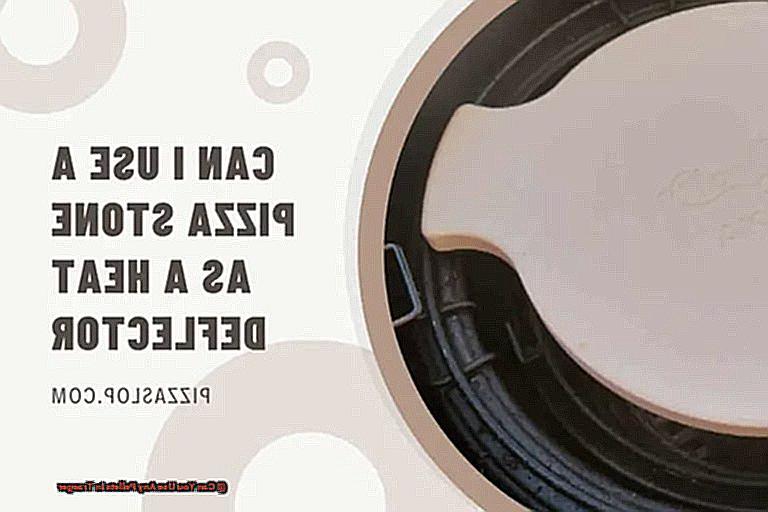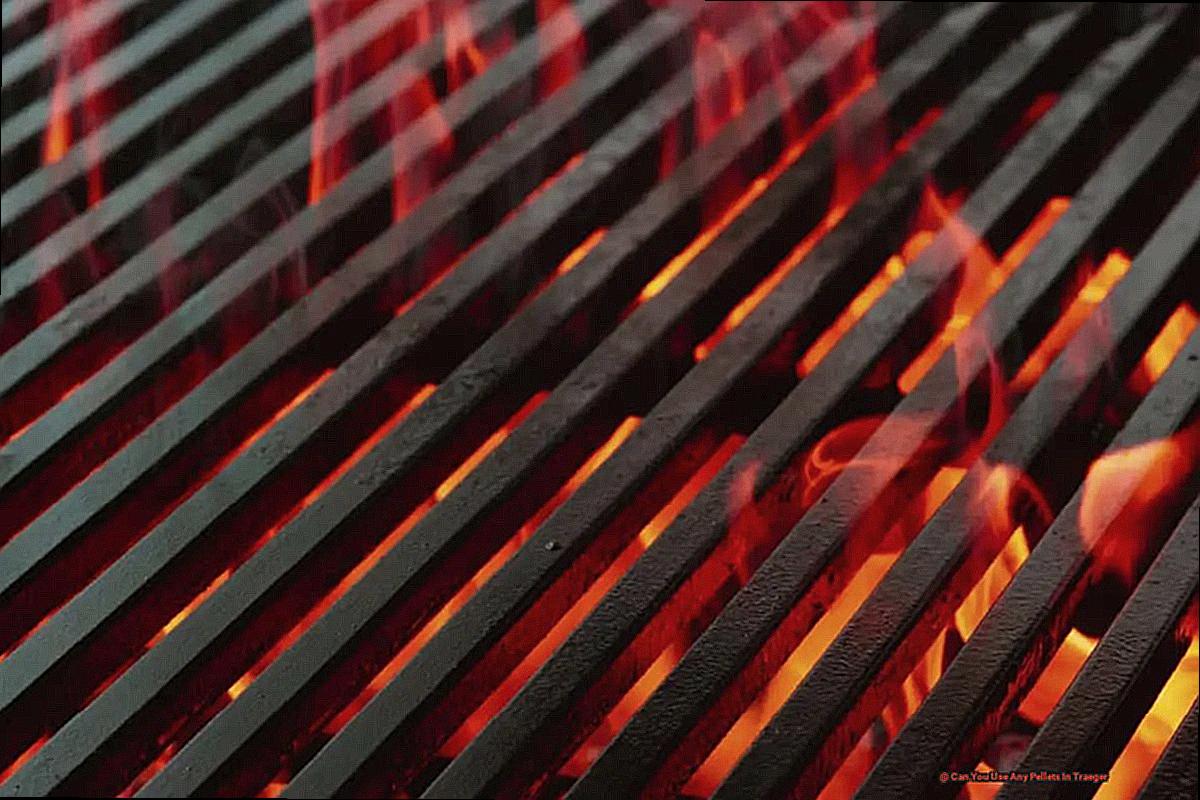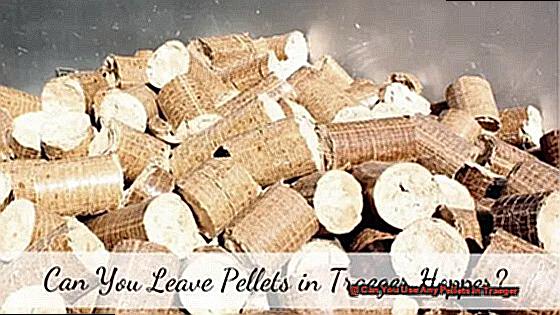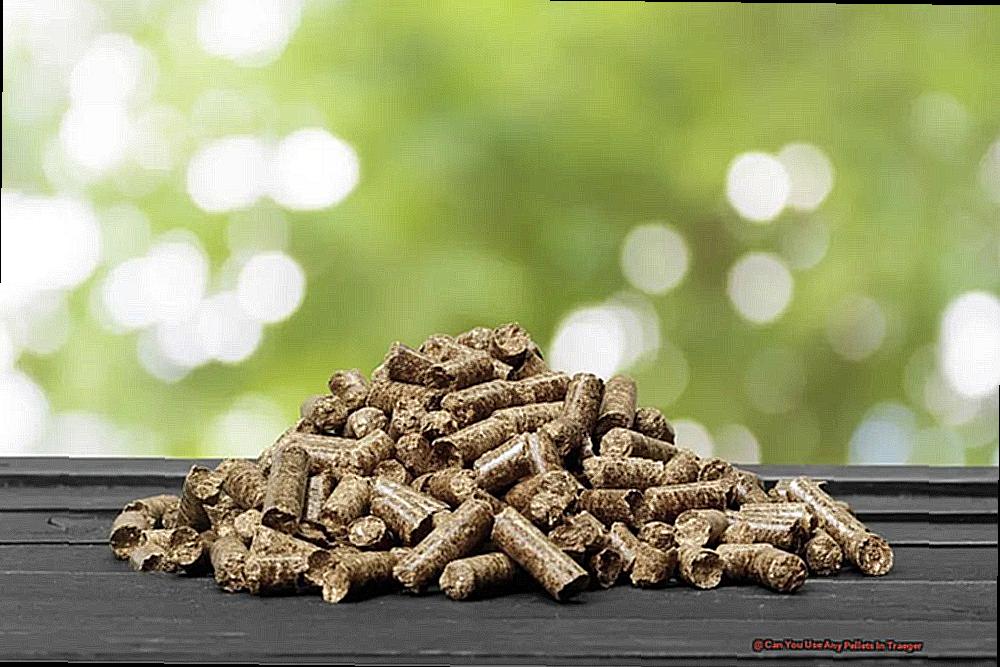Tired of the same old grilled meals? Ready to elevate your BBQ game? Look no further than Traeger grills and pellets. These cutting-edge grills use hardwood pellets as fuel, infusing your food with a mouth-watering smoky flavor that will have your taste buds dancing.
But that’s not all – there are plenty of other benefits to using pellets in your Traeger grill. Say goodbye to messy charcoal and propane tanks, and hello to a wide variety of wood flavors for customizable cooking. With precise temperature control, you can achieve perfect results every time. Plus, these grills are versatile enough to smoke, grill, bake, roast, and more.
Made from 100% natural hardwood with no fillers or additives, Traeger pellets are the perfect choice for any avid pitmaster or beginner griller. So get ready to impress your friends and family with delectable meals that will have them coming back for seconds (and thirds). It’s time to fire up those Traegers and let the deliciousness begin.
Contents
- 1 Is It Ok to Use Any Brand Pellets in a Traeger Grill?
- 2 Is It Necessary to Use Only Traeger Pellets in Their Grill?
- 3 What are the Best Pellets to Use in a Traeger?
- 4 Can You Use Regular Wood Pellets in a Traeger Grill?
- 5 Are Pellet Grills Bad for Our Health?
- 6 How Long Does a Bag of Traeger Pellets Last?
- 7 How Many Pellets Do I Need to Put in a Traeger Grill?
- 8 What to do When My Traeger Runs out of Pellets?
- 9 Conclusion
Is It Ok to Use Any Brand Pellets in a Traeger Grill?
While it is possible to use any brand of pellets in a Traeger grill, it is generally recommended to stick with Traeger brand pellets for optimal results. This is because Traeger pellets are specifically designed for use in Traeger grills, ensuring the best flavor and performance.
However, there are other brands of pellets that can also be used successfully in a Traeger grill. Some popular options include CookinPellets Perfect Mix, Lumber Jack 100% Hardwood, and BBQrs Delight Wood Smoking Pellets. These brands offer a variety of wood flavors to choose from for different dishes.
Ultimately, it is crucial to select high-quality, food-grade pellets that are 100% hardwood and dry for the best cooking experience. While Traeger brand pellets may be the first choice, there are other options available that can still deliver delicious results.
Is It Necessary to Use Only Traeger Pellets in Their Grill?
The answer is ambiguous, as there are both pros and cons to utilizing non-Traeger pellets in Traeger grills.
Benefits:
- Cost-effective: Non-Traeger pellets typically come at a lower price point compared to Traeger brand pellets, making them a more budget-friendly option for frequent users of Traeger grills.
- Wide range of flavors: Non-Traeger pellets are available in various flavors, including apple, cherry, hickory, and mesquite, allowing for more experimentation and customization in cooking.
- Convenient availability: Non-Traeger pellets can be easily found in most hardware stores or online, making it hassle-free to restock when needed.
Drawbacks:
- Inconsistent quality: While some non-Traeger pellets may provide satisfactory results, others may not burn as efficiently or produce as much smoke, resulting in an inconsistent cooking experience.
- Potential damage to grill: Low-quality or damp pellets can potentially cause harm to the internal components of the Traeger grill, resulting in expensive repairs.
- Voiding warranty: Using non-Traeger pellets may void the grill’s warranty if any damage occurs due to their use.
In conclusion, while it is possible to use non-Traeger pellets in a Traeger grill, it is advisable to stick with Traeger brand pellets for optimal outcomes and to avoid potential risks. However, if budget constraints or availability issues arise, high-quality non-Traeger pellets can also deliver satisfactory results.
What are the Best Pellets to Use in a Traeger?
When selecting the optimal pellets to use in a Traeger grill, there are several crucial factors to take into account. These include the type of pellets, their quality, size and shape, moisture content, availability, price, brand reputation, and compatibility with your specific Traeger grill model. Each of these aspects can significantly affect the taste and overall cooking performance of your Traeger grill, so it is vital to thoughtfully consider each one before making a decision.
One of the primary considerations when choosing pellets for your Traeger grill is the type of wood used. Different types of wood produce distinct flavors, so it is essential to select a wood that complements the specific dish you are cooking. For example, hickory is known for its bold and smoky flavor and pairs well with red meats, while applewood has a lighter and sweeter taste that works well with poultry and fish.
Moreover, the quality of the pellets can greatly impact the final result. High-quality pellets are made from pure wood without additives or fillers, resulting in a cleaner burn and better flavor. They also have a consistent size and shape, ensuring even heat distribution throughout the cooking process.
Another crucial factor is the moisture content of the pellets. Pellets with high moisture content can lead to inconsistent temperatures and potentially ruin your dish. On the other hand, dry pellets burn hotter and cleaner, resulting in more efficient cooking.
When it comes to availability and price, it is essential to strike a balance between convenience and cost-effectiveness. While some brands may be more readily available, they may come at a higher price point. It is important to do research and find a reputable brand that offers good quality pellets at a reasonable price.
Finally, make sure to choose pellets that are compatible with your specific Traeger grill model. While most pellets on the market are compatible with Traeger grills, it is crucial to double-check before making a purchase.
Can You Use Regular Wood Pellets in a Traeger Grill?
The answer is yes. Traeger grills are designed to work with all brands and types of wood pellets, making them a versatile option for BBQ enthusiasts. However, it is important to note that using different types of wood pellets may result in varying levels of smoke and flavor in your food. Therefore, it is recommended to stick with higher quality, food-grade pellets for the best results.
What sets Traeger grills apart?
Traeger grills are known for their versatility and ease of use. They can work with any brand or type of wood pellet, giving you the freedom to experiment with different flavors and types of wood. This makes them a popular choice among BBQ enthusiasts who love to try new things and elevate their cooking game.
Benefits of using regular wood pellets in a Traeger grill:
- Versatility: As mentioned earlier, Traeger grills can work with any type of wood pellet. This allows you to experiment with different flavors and types of wood, giving your food a unique and delicious taste.
- Cost-effective: Regular wood pellets tend to be more budget-friendly compared to specialized or flavored pellets, making them a more cost-effective option for frequent use. This makes it easier for you to enjoy delicious BBQ without breaking the bank.
- Availability: Regular wood pellets are widely available and can be easily found at most hardware stores, making them convenient for last-minute BBQ plans. You don’t have to worry about running out of pellets when you have unexpected guests over for a BBQ.
- Consistency: Traeger grills have a built-in auger system that controls the speed at which the pellets are fed into the fire, ensuring a consistent temperature throughout the cooking process. This helps you achieve perfectly cooked food every time.
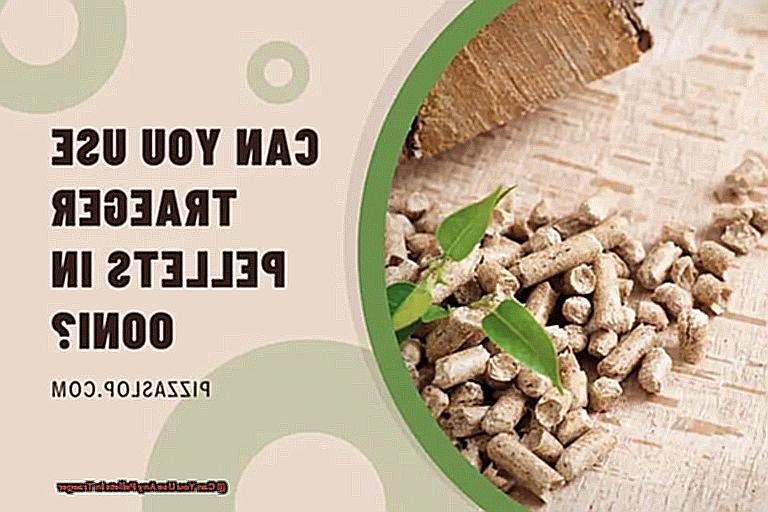
Factors to consider when choosing wood pellets for your Traeger grill:
- Wood type: Different types of wood will impart different flavors onto your food, so it is important to choose a type that complements the dish you are cooking. Popular options include mesquite, hickory, and applewood.
- Moisture content: High-quality pellets should have a moisture content below 6%, as excess moisture can cause inconsistent burning and affect the flavor of your food. Make sure to check the moisture content before purchasing your pellets.
- Brand reputation: Choosing a reputable brand ensures that you are getting high-quality, food-grade pellets that are free of harmful additives. This is important for both the taste and safety of your food.
Top recommended wood pellet brands for Traeger grills:
- Louisiana Grills Pennsylvania 0-Pound
- Pit Boss Natural Hardwood Pellets
- Lumber Jack BBQ Grilling Wood Pellets
- BBQrs Delight Wood Smoking Pellets – Super Smoker Variety Pack
- CookinPellets 0-Pound Perfect Mix Smoking Pellets
Are Pellet Grills Bad for Our Health?
There is no evidence to suggest that using different types of pellets in a Traeger grill poses any health risks. As long as the pellets are made from food-grade materials and do not contain harmful chemicals, they should not have adverse effects on our health.
On the contrary, using various types of pellets can add unique flavors to your BBQ dishes, making them more enjoyable for you and your guests. Each type of wood pellet, such as hickory, mesquite, and applewood, can impart distinct flavors to your food, giving you a range of options for flavoring your meals when cooking with a Traeger grill.
Moreover, Traeger grills utilize indirect heat and convection cooking methods, which are known to be healthier than traditional grilling techniques. These methods reduce the amount of fat that drips onto the heat source, resulting in less smoke and fewer harmful chemicals being released into the air.
However, it is worth noting that using low-quality or non-food grade pellets may result in an unpleasant taste or smell in your food. It is recommended to stick with reputable brands that use high-quality ingredients to ensure the best results and avoid any potential health risks.
How Long Does a Bag of Traeger Pellets Last?
The duration of a bag of Traeger pellets can vary greatly, but on average, it can last for approximately 20 hours of cooking time. However, this estimate is subject to change depending on factors such as temperature setting, cooking style, and hopper size.
To give you a better idea of the lifespan of different types of Traeger pellets, here is a breakdown:
- A 20-pound bag of pellets: 20 hours of cooking time
- A 33-pound bag of pellets: 33 hours of cooking time
- A 9-pound bag of pellets: 9 hours of cooking time
Several factors can affect the longevity of a bag of Traeger pellets, including:
- Temperature setting: Higher temperature settings will consume more pellets compared to lower ones.
- Cooking style: Slow-cooking or smoking dishes will require fewer pellets than grilling at high temperatures.
- Hopper size: The capacity of your hopper will determine how many pellets can be stored and used at one time.
To help you understand how much fuel you need for different temperature settings, here is a table showing the average amount of pellets used per hour:
| Temperature Setting | Average Pellets Used per Hour |
| 180°F | 1 pound |
| 225°F | 2 pounds |
| 250°F | 2.5 pounds |
| 275°F | 3 pounds |
| 300°F | 3.5 pounds |
| 325°F | 4 pounds |
| 350°F | 4.5 pounds |
| 375°F | 5 pounds |
| 400°F | 5.5 pounds |
| 425°F | 6 pounds |
| 450°F | 6.5 pounds |
| 475°F | 7 pounds |
| 500°F | 7.5 pounds |
It’s essential to keep in mind that these numbers are just averages and can vary based on the factors mentioned above. It’s always a good idea to have extra pellets on hand, especially if you plan on cooking for an extended period.
How Many Pellets Do I Need to Put in a Traeger Grill?
When determining the perfect amount of pellets for your Traeger grill, there are several important factors to consider. These include the type of pellets used, temperature setting, cooking style and personal preferences.
Type of Pellets:
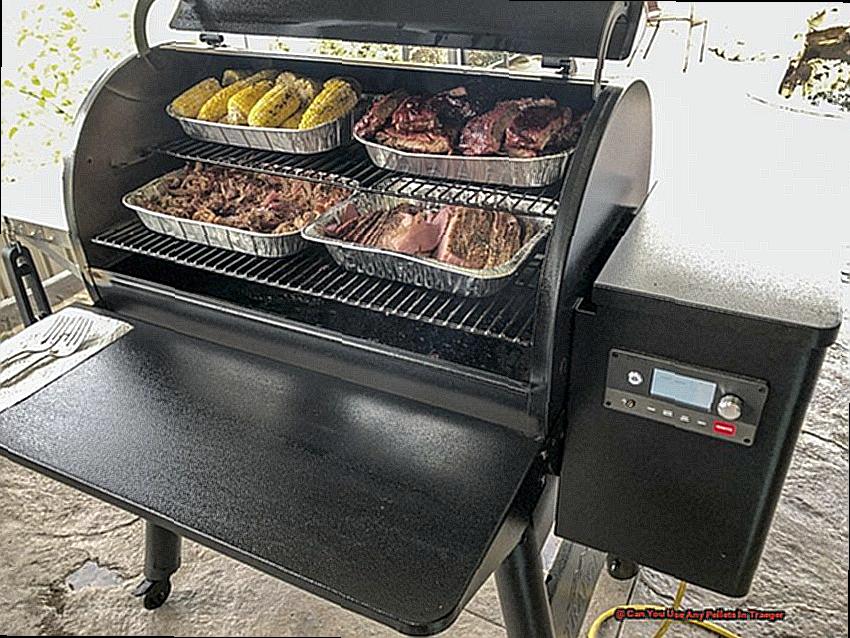
The type of pellets you choose can significantly impact the amount needed for optimal cooking results. High-quality pellets, made from 100% hardwood with no fillers, tend to last longer and produce less ash. This means you won’t have to refill them as often, saving on pellet usage.
Temperature Setting:
The temperature setting on your Traeger grill also plays a crucial role in determining pellet usage. Higher temperatures will burn through pellets more quickly, while lower temperatures conserve them. For example, cooking at 300 degrees Fahrenheit will use more pellets than cooking at 225 degrees Fahrenheit.
Cooking Style:
Your cooking style can also affect the amount of pellets used on your Traeger grill. Indirect cooking methods, such as smoking or using a smoker box or tube, can infuse food with a smoky flavor without using up as many pellets. This is because the smoke created by the pellets is being used for flavor rather than just heat.
Personal Preferences:
Lastly, personal preferences play a significant role in determining pellet usage. Some people prefer a stronger smoky flavor in their food, while others may not want as much smoke. This will impact the number of pellets used per hour.
In general, it’s recommended to keep extra pellets on hand when using a Traeger grill. It’s better to have too many than not enough, as running out of pellets mid-cooking can affect the overall taste and quality of your food. Additionally, proper calibration of your grill, keeping it clean and using a grill cover when not in use can help save on pellet usage.
| Type of Pellets | Temperature Setting | Cooking Style |
| High-quality pellets (100% hardwood, no fillers) |
Lower temperatures | Indirect cooking methods (smoking, using a smoker box or tube) |
| Lower-quality pellets (with fillers) |
Higher temperatures | Direct cooking methods (grilling, searing) |
In conclusion, the perfect amount of pellets to use in a Traeger grill for optimal cooking results will vary depending on individual preferences and factors such as pellet type and cooking style.
What to do When My Traeger Runs out of Pellets?
In the unfortunate event that your Traeger grill runs out of pellets mid-cook, there is no need to worry. Follow these steps to ensure that your grilling experience is not compromised in terms of flavor or safety.
- Remain calm and do not panic: Running out of pellets during a cook is not an emergency and can be resolved easily.
- Allow the grill to cool down before attempting to restart it: This will prevent any potential accidents or burns.
- Refill the auger with food-grade, 100% hardwood, dry pellets before restarting the grill: This will guarantee the best results.
- Keep extra pellets on hand for future cooks: It’s always a good idea to have backup pellets available in case you run out during a cook.
- Remove your food from the grill and place it on a heat-resistant surface or in a preheated oven: This will maintain the temperature and prevent your food from overcooking while you refill the pellets.
- Switch your grill to the “Shut Down Cycle” or “OFF” position, depending on your model: This will allow you to safely refill the pellets without any potential hazards.
- Check the auger and hopper for any remaining pellets or debris: This will ensure that there are no obstructions that could affect the burning process.
- Monitor your pellet levels during cooking: Pay attention to how quickly your pellets are burning and add more if needed to avoid running out again.
- Consider alternative options for finishing your cook: If you do run out of pellets, you can either add more, stretch the remaining ones, finish cooking in the oven, use a different fuel source, or end the cook early to still enjoy a delicious meal with your loved ones.
- Always keep important factors in mind when using pellets in a Traeger grill: Use only food-grade, 100% hardwood, dry pellets and choose the right type of wood for your desired flavor profile. Also, properly store your pellets to ensure they are dry and ready to use.
By following these steps and guidelines, you can easily continue grilling even if your Traeger runs out of pellets.
Conclusion
In conclusion, Traeger grills and pellets are a game-changer for anyone seeking to elevate their BBQ experience.
Not only do they impart a tantalizing smoky flavor to your food, but they also offer precise temperature control, versatile cooking methods, and a variety of wood flavors for customizable cooking. While Traeger brand pellets are recommended for optimal results, there are other high-quality options available that can still deliver mouth-watering meals.
However, it is crucial to consider factors such as wood type, moisture content, brand reputation, and compatibility with your specific Traeger grill model when selecting pellets.
After all, the right choice of pellets can make all the difference in the taste and quality of your dishes.
You may also like:

